Comprehensive Analysis of Budget Reforms on the Tourism Industry
VerifiedAdded on 2020/03/07
|7
|1575
|166
Report
AI Summary
This report examines the impact of the 2017 Australian federal budget reforms on the tourism industry. It analyzes the effects of reduced funding for Tourism Australia, increased visa fees, and the government's failure to establish a National Convention Bids Fund. The report highlights the importance of tourism to the Australian economy, referencing its contribution to GDP and employment. It discusses the potential negative effects of budget cuts and visa fee increases, while also acknowledging positive aspects such as funding for tourism-reliant sectors and infrastructure development. The report provides recommendations, including maintaining competitive visa fees, investing in infrastructure, developing skills, and establishing the National Convention Bids Fund. The analysis draws on various sources, including government reports, news articles, and academic studies, to provide a comprehensive overview of the issues and potential solutions for ensuring the continued growth and competitiveness of the Australian tourism industry. The report concludes that the tourism industry is intertwined with socioeconomic variables such as politics, infrastructure, and economic policies and therefore, these variables must be set right for the industry to succeed.
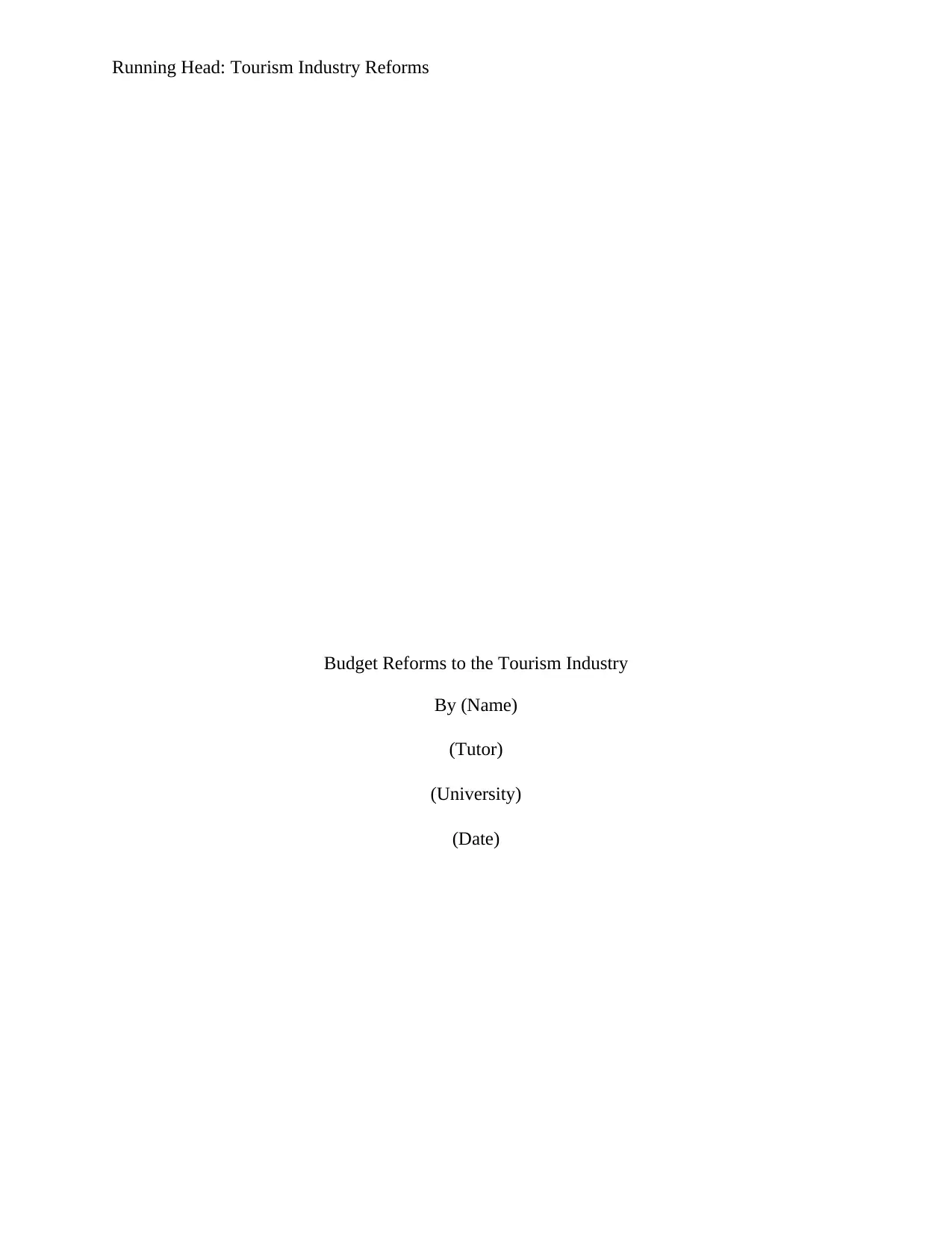
Running Head: Tourism Industry Reforms
Budget Reforms to the Tourism Industry
By (Name)
(Tutor)
(University)
(Date)
Budget Reforms to the Tourism Industry
By (Name)
(Tutor)
(University)
(Date)
Paraphrase This Document
Need a fresh take? Get an instant paraphrase of this document with our AI Paraphraser
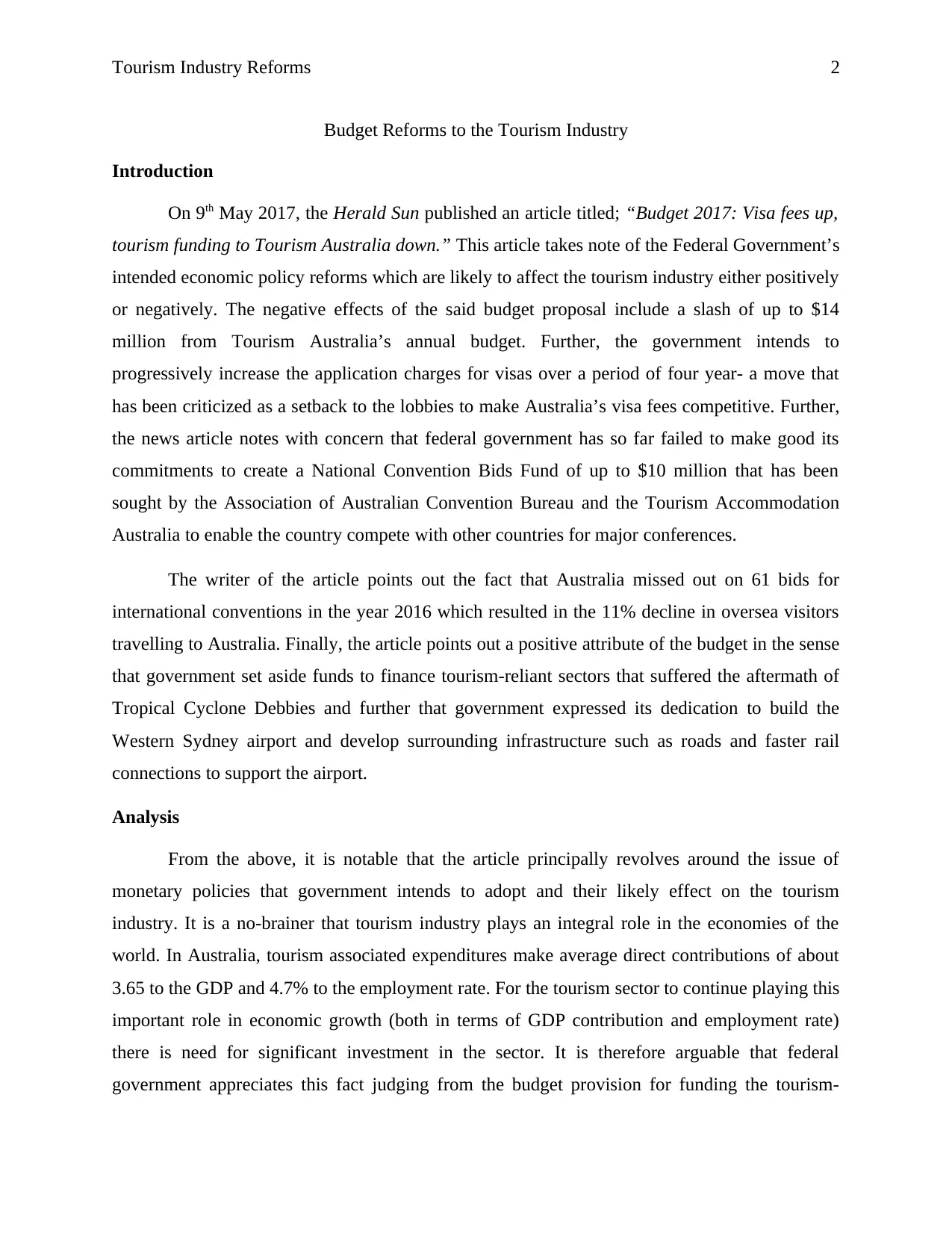
Tourism Industry Reforms 2
Budget Reforms to the Tourism Industry
Introduction
On 9th May 2017, the Herald Sun published an article titled; “Budget 2017: Visa fees up,
tourism funding to Tourism Australia down.” This article takes note of the Federal Government’s
intended economic policy reforms which are likely to affect the tourism industry either positively
or negatively. The negative effects of the said budget proposal include a slash of up to $14
million from Tourism Australia’s annual budget. Further, the government intends to
progressively increase the application charges for visas over a period of four year- a move that
has been criticized as a setback to the lobbies to make Australia’s visa fees competitive. Further,
the news article notes with concern that federal government has so far failed to make good its
commitments to create a National Convention Bids Fund of up to $10 million that has been
sought by the Association of Australian Convention Bureau and the Tourism Accommodation
Australia to enable the country compete with other countries for major conferences.
The writer of the article points out the fact that Australia missed out on 61 bids for
international conventions in the year 2016 which resulted in the 11% decline in oversea visitors
travelling to Australia. Finally, the article points out a positive attribute of the budget in the sense
that government set aside funds to finance tourism-reliant sectors that suffered the aftermath of
Tropical Cyclone Debbies and further that government expressed its dedication to build the
Western Sydney airport and develop surrounding infrastructure such as roads and faster rail
connections to support the airport.
Analysis
From the above, it is notable that the article principally revolves around the issue of
monetary policies that government intends to adopt and their likely effect on the tourism
industry. It is a no-brainer that tourism industry plays an integral role in the economies of the
world. In Australia, tourism associated expenditures make average direct contributions of about
3.65 to the GDP and 4.7% to the employment rate. For the tourism sector to continue playing this
important role in economic growth (both in terms of GDP contribution and employment rate)
there is need for significant investment in the sector. It is therefore arguable that federal
government appreciates this fact judging from the budget provision for funding the tourism-
Budget Reforms to the Tourism Industry
Introduction
On 9th May 2017, the Herald Sun published an article titled; “Budget 2017: Visa fees up,
tourism funding to Tourism Australia down.” This article takes note of the Federal Government’s
intended economic policy reforms which are likely to affect the tourism industry either positively
or negatively. The negative effects of the said budget proposal include a slash of up to $14
million from Tourism Australia’s annual budget. Further, the government intends to
progressively increase the application charges for visas over a period of four year- a move that
has been criticized as a setback to the lobbies to make Australia’s visa fees competitive. Further,
the news article notes with concern that federal government has so far failed to make good its
commitments to create a National Convention Bids Fund of up to $10 million that has been
sought by the Association of Australian Convention Bureau and the Tourism Accommodation
Australia to enable the country compete with other countries for major conferences.
The writer of the article points out the fact that Australia missed out on 61 bids for
international conventions in the year 2016 which resulted in the 11% decline in oversea visitors
travelling to Australia. Finally, the article points out a positive attribute of the budget in the sense
that government set aside funds to finance tourism-reliant sectors that suffered the aftermath of
Tropical Cyclone Debbies and further that government expressed its dedication to build the
Western Sydney airport and develop surrounding infrastructure such as roads and faster rail
connections to support the airport.
Analysis
From the above, it is notable that the article principally revolves around the issue of
monetary policies that government intends to adopt and their likely effect on the tourism
industry. It is a no-brainer that tourism industry plays an integral role in the economies of the
world. In Australia, tourism associated expenditures make average direct contributions of about
3.65 to the GDP and 4.7% to the employment rate. For the tourism sector to continue playing this
important role in economic growth (both in terms of GDP contribution and employment rate)
there is need for significant investment in the sector. It is therefore arguable that federal
government appreciates this fact judging from the budget provision for funding the tourism-
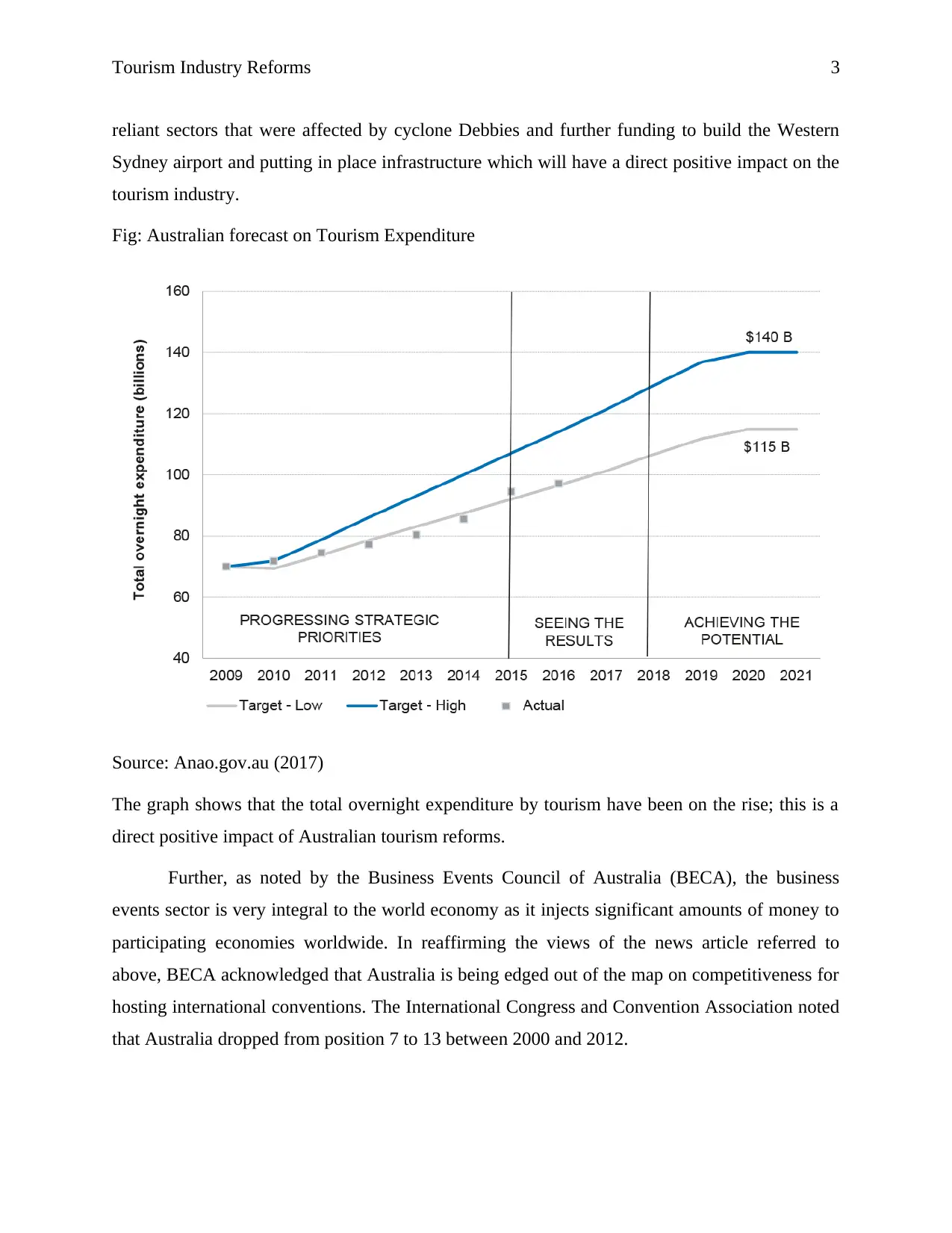
Tourism Industry Reforms 3
reliant sectors that were affected by cyclone Debbies and further funding to build the Western
Sydney airport and putting in place infrastructure which will have a direct positive impact on the
tourism industry.
Fig: Australian forecast on Tourism Expenditure
Source: Anao.gov.au (2017)
The graph shows that the total overnight expenditure by tourism have been on the rise; this is a
direct positive impact of Australian tourism reforms.
Further, as noted by the Business Events Council of Australia (BECA), the business
events sector is very integral to the world economy as it injects significant amounts of money to
participating economies worldwide. In reaffirming the views of the news article referred to
above, BECA acknowledged that Australia is being edged out of the map on competitiveness for
hosting international conventions. The International Congress and Convention Association noted
that Australia dropped from position 7 to 13 between 2000 and 2012.
reliant sectors that were affected by cyclone Debbies and further funding to build the Western
Sydney airport and putting in place infrastructure which will have a direct positive impact on the
tourism industry.
Fig: Australian forecast on Tourism Expenditure
Source: Anao.gov.au (2017)
The graph shows that the total overnight expenditure by tourism have been on the rise; this is a
direct positive impact of Australian tourism reforms.
Further, as noted by the Business Events Council of Australia (BECA), the business
events sector is very integral to the world economy as it injects significant amounts of money to
participating economies worldwide. In reaffirming the views of the news article referred to
above, BECA acknowledged that Australia is being edged out of the map on competitiveness for
hosting international conventions. The International Congress and Convention Association noted
that Australia dropped from position 7 to 13 between 2000 and 2012.
⊘ This is a preview!⊘
Do you want full access?
Subscribe today to unlock all pages.

Trusted by 1+ million students worldwide
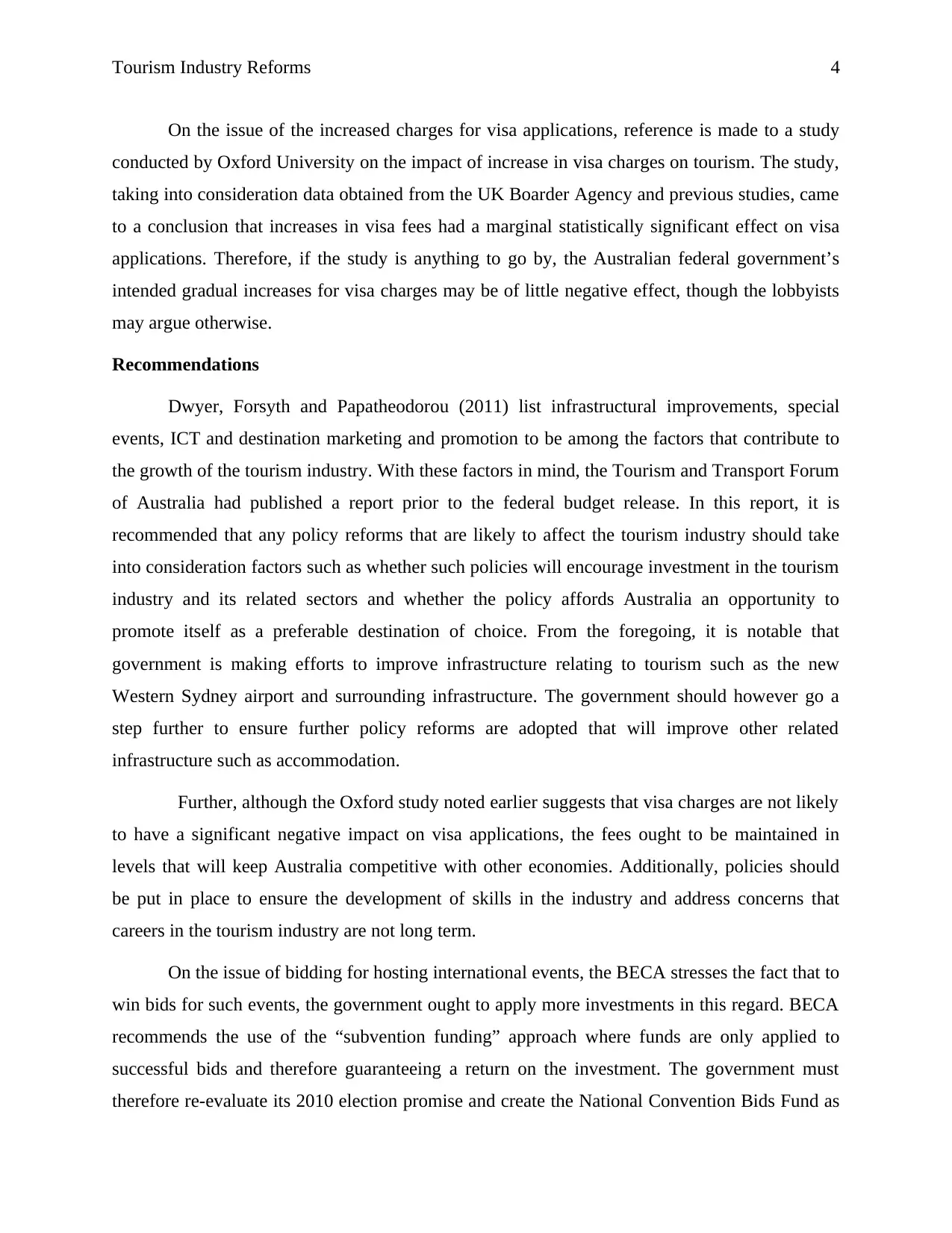
Tourism Industry Reforms 4
On the issue of the increased charges for visa applications, reference is made to a study
conducted by Oxford University on the impact of increase in visa charges on tourism. The study,
taking into consideration data obtained from the UK Boarder Agency and previous studies, came
to a conclusion that increases in visa fees had a marginal statistically significant effect on visa
applications. Therefore, if the study is anything to go by, the Australian federal government’s
intended gradual increases for visa charges may be of little negative effect, though the lobbyists
may argue otherwise.
Recommendations
Dwyer, Forsyth and Papatheodorou (2011) list infrastructural improvements, special
events, ICT and destination marketing and promotion to be among the factors that contribute to
the growth of the tourism industry. With these factors in mind, the Tourism and Transport Forum
of Australia had published a report prior to the federal budget release. In this report, it is
recommended that any policy reforms that are likely to affect the tourism industry should take
into consideration factors such as whether such policies will encourage investment in the tourism
industry and its related sectors and whether the policy affords Australia an opportunity to
promote itself as a preferable destination of choice. From the foregoing, it is notable that
government is making efforts to improve infrastructure relating to tourism such as the new
Western Sydney airport and surrounding infrastructure. The government should however go a
step further to ensure further policy reforms are adopted that will improve other related
infrastructure such as accommodation.
Further, although the Oxford study noted earlier suggests that visa charges are not likely
to have a significant negative impact on visa applications, the fees ought to be maintained in
levels that will keep Australia competitive with other economies. Additionally, policies should
be put in place to ensure the development of skills in the industry and address concerns that
careers in the tourism industry are not long term.
On the issue of bidding for hosting international events, the BECA stresses the fact that to
win bids for such events, the government ought to apply more investments in this regard. BECA
recommends the use of the “subvention funding” approach where funds are only applied to
successful bids and therefore guaranteeing a return on the investment. The government must
therefore re-evaluate its 2010 election promise and create the National Convention Bids Fund as
On the issue of the increased charges for visa applications, reference is made to a study
conducted by Oxford University on the impact of increase in visa charges on tourism. The study,
taking into consideration data obtained from the UK Boarder Agency and previous studies, came
to a conclusion that increases in visa fees had a marginal statistically significant effect on visa
applications. Therefore, if the study is anything to go by, the Australian federal government’s
intended gradual increases for visa charges may be of little negative effect, though the lobbyists
may argue otherwise.
Recommendations
Dwyer, Forsyth and Papatheodorou (2011) list infrastructural improvements, special
events, ICT and destination marketing and promotion to be among the factors that contribute to
the growth of the tourism industry. With these factors in mind, the Tourism and Transport Forum
of Australia had published a report prior to the federal budget release. In this report, it is
recommended that any policy reforms that are likely to affect the tourism industry should take
into consideration factors such as whether such policies will encourage investment in the tourism
industry and its related sectors and whether the policy affords Australia an opportunity to
promote itself as a preferable destination of choice. From the foregoing, it is notable that
government is making efforts to improve infrastructure relating to tourism such as the new
Western Sydney airport and surrounding infrastructure. The government should however go a
step further to ensure further policy reforms are adopted that will improve other related
infrastructure such as accommodation.
Further, although the Oxford study noted earlier suggests that visa charges are not likely
to have a significant negative impact on visa applications, the fees ought to be maintained in
levels that will keep Australia competitive with other economies. Additionally, policies should
be put in place to ensure the development of skills in the industry and address concerns that
careers in the tourism industry are not long term.
On the issue of bidding for hosting international events, the BECA stresses the fact that to
win bids for such events, the government ought to apply more investments in this regard. BECA
recommends the use of the “subvention funding” approach where funds are only applied to
successful bids and therefore guaranteeing a return on the investment. The government must
therefore re-evaluate its 2010 election promise and create the National Convention Bids Fund as
Paraphrase This Document
Need a fresh take? Get an instant paraphrase of this document with our AI Paraphraser
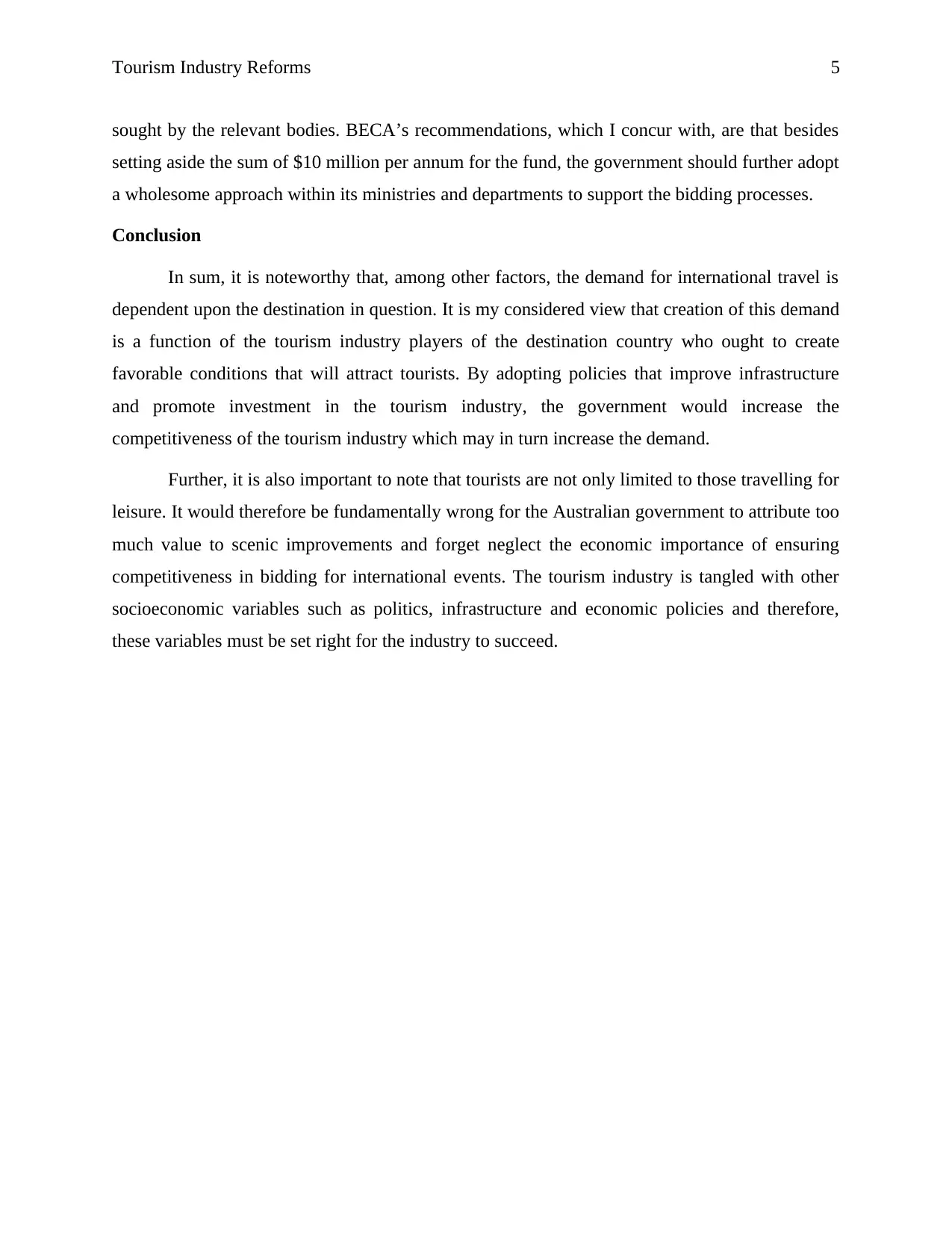
Tourism Industry Reforms 5
sought by the relevant bodies. BECA’s recommendations, which I concur with, are that besides
setting aside the sum of $10 million per annum for the fund, the government should further adopt
a wholesome approach within its ministries and departments to support the bidding processes.
Conclusion
In sum, it is noteworthy that, among other factors, the demand for international travel is
dependent upon the destination in question. It is my considered view that creation of this demand
is a function of the tourism industry players of the destination country who ought to create
favorable conditions that will attract tourists. By adopting policies that improve infrastructure
and promote investment in the tourism industry, the government would increase the
competitiveness of the tourism industry which may in turn increase the demand.
Further, it is also important to note that tourists are not only limited to those travelling for
leisure. It would therefore be fundamentally wrong for the Australian government to attribute too
much value to scenic improvements and forget neglect the economic importance of ensuring
competitiveness in bidding for international events. The tourism industry is tangled with other
socioeconomic variables such as politics, infrastructure and economic policies and therefore,
these variables must be set right for the industry to succeed.
sought by the relevant bodies. BECA’s recommendations, which I concur with, are that besides
setting aside the sum of $10 million per annum for the fund, the government should further adopt
a wholesome approach within its ministries and departments to support the bidding processes.
Conclusion
In sum, it is noteworthy that, among other factors, the demand for international travel is
dependent upon the destination in question. It is my considered view that creation of this demand
is a function of the tourism industry players of the destination country who ought to create
favorable conditions that will attract tourists. By adopting policies that improve infrastructure
and promote investment in the tourism industry, the government would increase the
competitiveness of the tourism industry which may in turn increase the demand.
Further, it is also important to note that tourists are not only limited to those travelling for
leisure. It would therefore be fundamentally wrong for the Australian government to attribute too
much value to scenic improvements and forget neglect the economic importance of ensuring
competitiveness in bidding for international events. The tourism industry is tangled with other
socioeconomic variables such as politics, infrastructure and economic policies and therefore,
these variables must be set right for the industry to succeed.
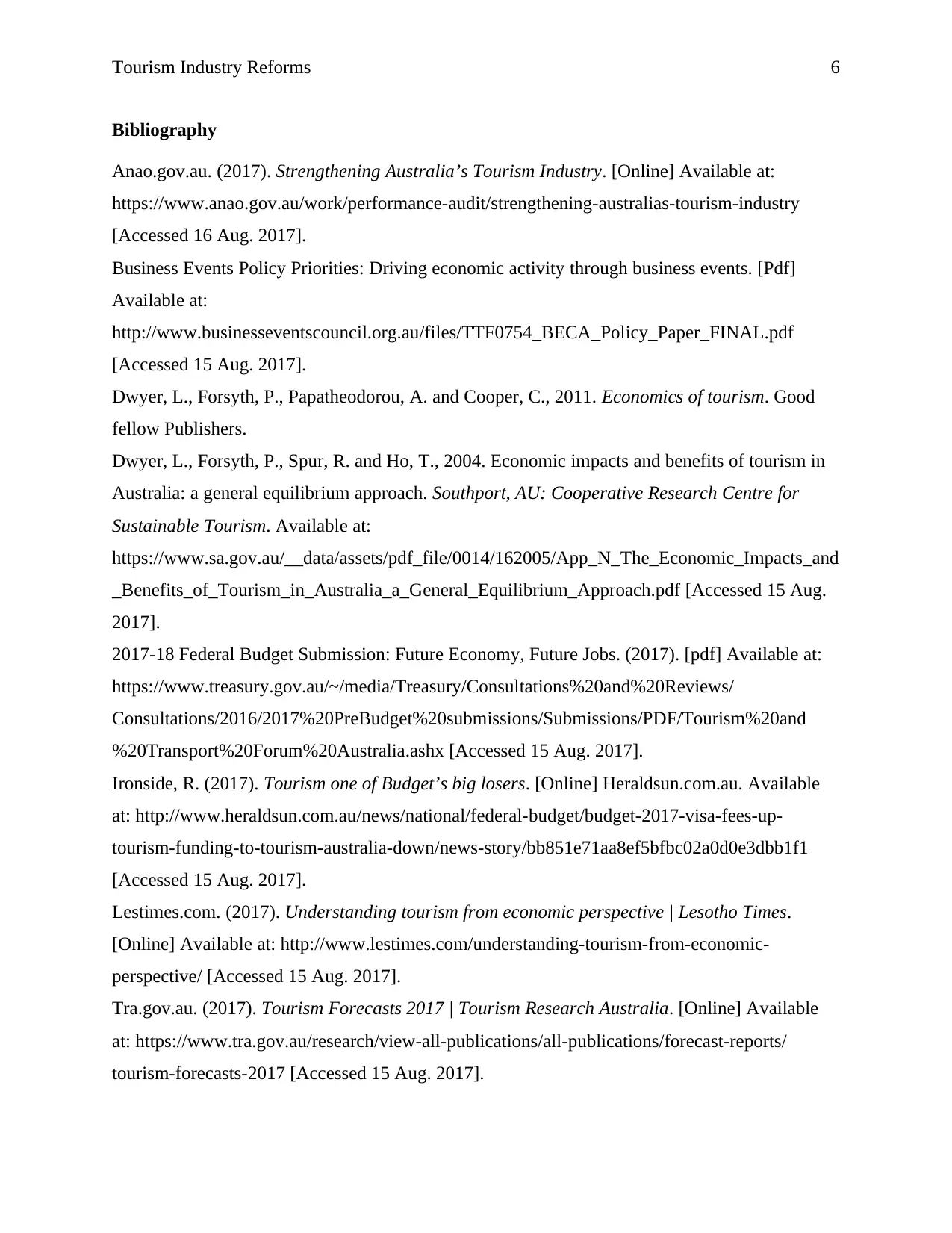
Tourism Industry Reforms 6
Bibliography
Anao.gov.au. (2017). Strengthening Australia’s Tourism Industry. [Online] Available at:
https://www.anao.gov.au/work/performance-audit/strengthening-australias-tourism-industry
[Accessed 16 Aug. 2017].
Business Events Policy Priorities: Driving economic activity through business events. [Pdf]
Available at:
http://www.businesseventscouncil.org.au/files/TTF0754_BECA_Policy_Paper_FINAL.pdf
[Accessed 15 Aug. 2017].
Dwyer, L., Forsyth, P., Papatheodorou, A. and Cooper, C., 2011. Economics of tourism. Good
fellow Publishers.
Dwyer, L., Forsyth, P., Spur, R. and Ho, T., 2004. Economic impacts and benefits of tourism in
Australia: a general equilibrium approach. Southport, AU: Cooperative Research Centre for
Sustainable Tourism. Available at:
https://www.sa.gov.au/__data/assets/pdf_file/0014/162005/App_N_The_Economic_Impacts_and
_Benefits_of_Tourism_in_Australia_a_General_Equilibrium_Approach.pdf [Accessed 15 Aug.
2017].
2017-18 Federal Budget Submission: Future Economy, Future Jobs. (2017). [pdf] Available at:
https://www.treasury.gov.au/~/media/Treasury/Consultations%20and%20Reviews/
Consultations/2016/2017%20PreBudget%20submissions/Submissions/PDF/Tourism%20and
%20Transport%20Forum%20Australia.ashx [Accessed 15 Aug. 2017].
Ironside, R. (2017). Tourism one of Budget’s big losers. [Online] Heraldsun.com.au. Available
at: http://www.heraldsun.com.au/news/national/federal-budget/budget-2017-visa-fees-up-
tourism-funding-to-tourism-australia-down/news-story/bb851e71aa8ef5bfbc02a0d0e3dbb1f1
[Accessed 15 Aug. 2017].
Lestimes.com. (2017). Understanding tourism from economic perspective | Lesotho Times.
[Online] Available at: http://www.lestimes.com/understanding-tourism-from-economic-
perspective/ [Accessed 15 Aug. 2017].
Tra.gov.au. (2017). Tourism Forecasts 2017 | Tourism Research Australia. [Online] Available
at: https://www.tra.gov.au/research/view-all-publications/all-publications/forecast-reports/
tourism-forecasts-2017 [Accessed 15 Aug. 2017].
Bibliography
Anao.gov.au. (2017). Strengthening Australia’s Tourism Industry. [Online] Available at:
https://www.anao.gov.au/work/performance-audit/strengthening-australias-tourism-industry
[Accessed 16 Aug. 2017].
Business Events Policy Priorities: Driving economic activity through business events. [Pdf]
Available at:
http://www.businesseventscouncil.org.au/files/TTF0754_BECA_Policy_Paper_FINAL.pdf
[Accessed 15 Aug. 2017].
Dwyer, L., Forsyth, P., Papatheodorou, A. and Cooper, C., 2011. Economics of tourism. Good
fellow Publishers.
Dwyer, L., Forsyth, P., Spur, R. and Ho, T., 2004. Economic impacts and benefits of tourism in
Australia: a general equilibrium approach. Southport, AU: Cooperative Research Centre for
Sustainable Tourism. Available at:
https://www.sa.gov.au/__data/assets/pdf_file/0014/162005/App_N_The_Economic_Impacts_and
_Benefits_of_Tourism_in_Australia_a_General_Equilibrium_Approach.pdf [Accessed 15 Aug.
2017].
2017-18 Federal Budget Submission: Future Economy, Future Jobs. (2017). [pdf] Available at:
https://www.treasury.gov.au/~/media/Treasury/Consultations%20and%20Reviews/
Consultations/2016/2017%20PreBudget%20submissions/Submissions/PDF/Tourism%20and
%20Transport%20Forum%20Australia.ashx [Accessed 15 Aug. 2017].
Ironside, R. (2017). Tourism one of Budget’s big losers. [Online] Heraldsun.com.au. Available
at: http://www.heraldsun.com.au/news/national/federal-budget/budget-2017-visa-fees-up-
tourism-funding-to-tourism-australia-down/news-story/bb851e71aa8ef5bfbc02a0d0e3dbb1f1
[Accessed 15 Aug. 2017].
Lestimes.com. (2017). Understanding tourism from economic perspective | Lesotho Times.
[Online] Available at: http://www.lestimes.com/understanding-tourism-from-economic-
perspective/ [Accessed 15 Aug. 2017].
Tra.gov.au. (2017). Tourism Forecasts 2017 | Tourism Research Australia. [Online] Available
at: https://www.tra.gov.au/research/view-all-publications/all-publications/forecast-reports/
tourism-forecasts-2017 [Accessed 15 Aug. 2017].
⊘ This is a preview!⊘
Do you want full access?
Subscribe today to unlock all pages.

Trusted by 1+ million students worldwide
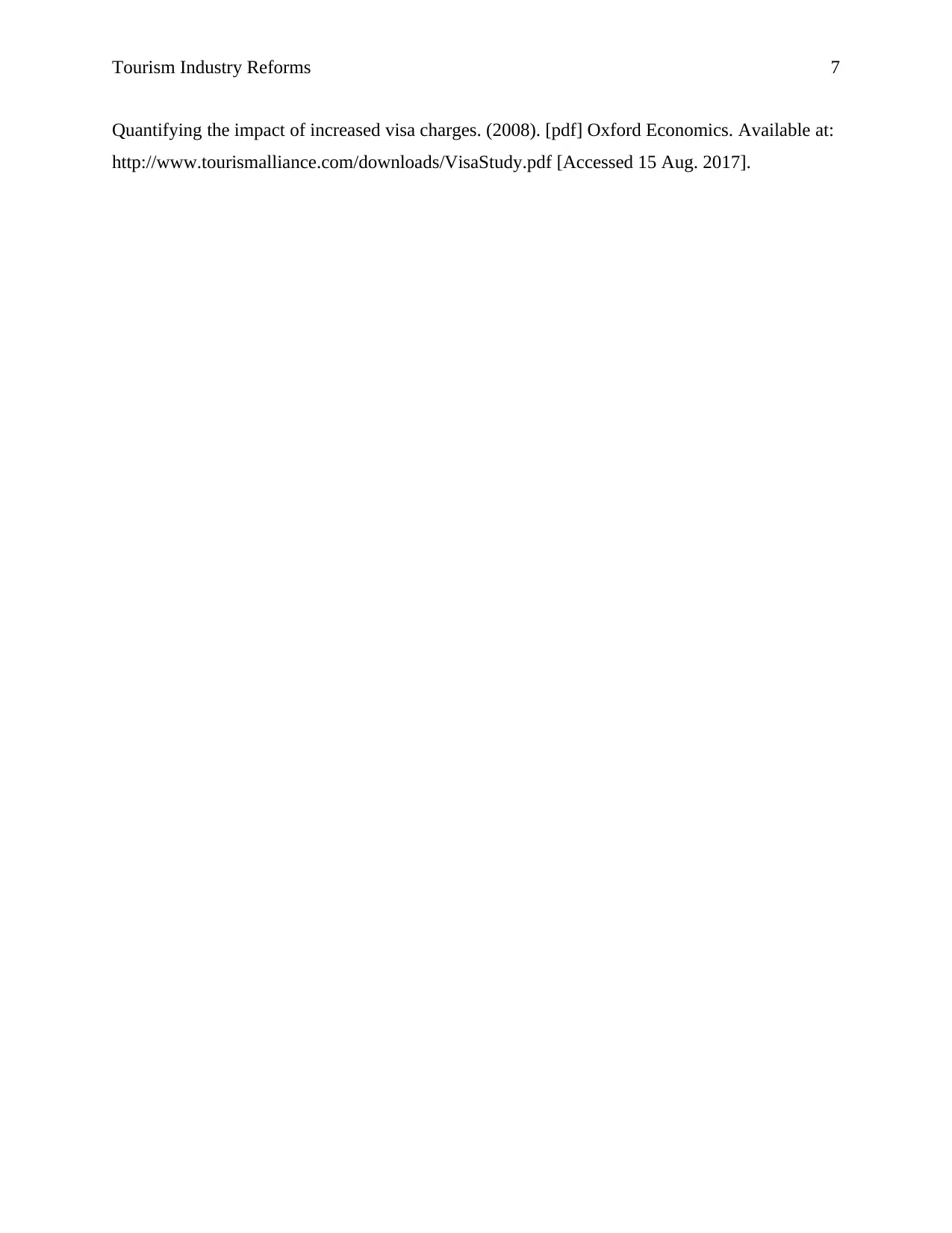
Tourism Industry Reforms 7
Quantifying the impact of increased visa charges. (2008). [pdf] Oxford Economics. Available at:
http://www.tourismalliance.com/downloads/VisaStudy.pdf [Accessed 15 Aug. 2017].
Quantifying the impact of increased visa charges. (2008). [pdf] Oxford Economics. Available at:
http://www.tourismalliance.com/downloads/VisaStudy.pdf [Accessed 15 Aug. 2017].
1 out of 7
Your All-in-One AI-Powered Toolkit for Academic Success.
+13062052269
info@desklib.com
Available 24*7 on WhatsApp / Email
![[object Object]](/_next/static/media/star-bottom.7253800d.svg)
Unlock your academic potential
Copyright © 2020–2025 A2Z Services. All Rights Reserved. Developed and managed by ZUCOL.

